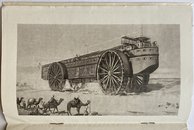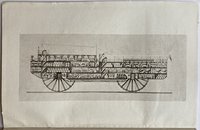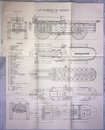Le Vaisseau Transsaharien
[Bischoff, Christian]. Le Vaisseau Transsaharien.
S.l., s.d. [Paris, S. Sandberg, c. 1927]
(24.5 x 16 cm). [1] 2-15 [16] pp. Two illustrated plates and a large folding plate (56 x 43 cm). Publisher’s original illustrated covers. Some wear and splits starting at the spine, otherwise a near fine copy.
FULL DESCRIPTION: Vaisseau Transsaharien
The cover image on this curious pamphlet (right) bears a distinctly science fiction element, but the development of this massive machine was very real, as this French language prospectus demonstrates. Conceived by the German inventor Christian Bischoff, this industrial wonder was also described in “Bibliothek der Unterhaltung und des Wissens”, vol. 7, Berlin, 1927. RARE: No trace of this version of the pamphlet, nor one that seems to correspond to a separate printing in German.
German industrial might: transporting the masses in desert ships of unprecedented proportions:
The concessionaire who issued this pamphlet, S. Sandberg, emphasized that, “the invention was created by advanced German engineers in collaboration with the formidable industries in their country.” Further, Sandberg indicates that a “Société Anonyme” is in formation, underscoring the pamphlet’s function as a means of promotion and fundraising, a strategy not unlike among today’s modern start-ups.
Intended for transporting large numbers of persons across the desert, Das Wüstenschiff [le vaisseau de désert or, ‘desert ship’] was designed as a means to counter the expense and difficulty of constructing roads or railways across vast stretches of uninhabited areas such as the Gobi or the Sahara Desert. Not to be confused with the automobile, as the pamphlet tells us, the vaisseau de desert represents an original means of locomotive transportation, and a daunting one: it was conceived during a period of German rearmament and investment in the Wehrmacht.
The pamphlet describes all aspects of the ship: the dimensions as follows: “a length of 40 meters over a width at the front of 8 meters and a maximum height of 13 m. 50 measured from the ground to the upper deck”; for the travelers: “Of the 150 passengers, 50 are housed in cabins, while hammocks are provided for the others. The necessary living rooms and dining rooms are provided.” For the staff: “1 driver and 2 assistants, 3 mechanics, 1 cook and 2 assistants, 2 stewards, 1 stewardess and 4 crew members. Accommodations for a doctor can also be met.” p.5.
Driven by two diesel motors of 450 horsepower, equipped with an on-board telegraph system for communication between the driver and the engine room, lights for nighttime navigation, a refrigeration system for food supplies, bathrooms, etc. Although was not fully realized, a photograph from 1932 confirms that Bischoff did construct a scale model of his desert ship, which is documented here by a large and highly detailed folding plate. A valuable prospectus documenting an innovative project the development of which was coincided with Germany's rearmament.



